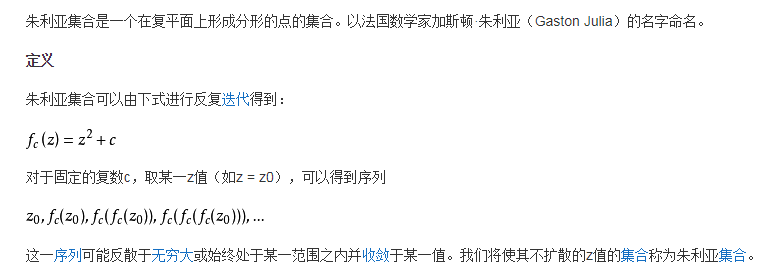Python高性能编程2014版中2.3采用了Julia集合作为范例来作为性能分析的范例,下面是作为一个python初阶使用者在学习示例中遇到的一些问题,我在这里把他们记录下来,作为备忘。同时希望能够帮助到后续学习该书的同学解决一些疑点。
首先是对Julia集合的介绍。以下关于Julia集合的定义摘自百度百科。
图1-Julia集合的定义
本章需要做的事情是采用代码去生成这个集合,并且在其中加上对于代码的部分性能分析,代码不展示ru生成图形的部分。下面
是生成Julia集合的代码。
def calc_pure_python(desired_width, max_iterations):
"""Create a list of complex coordinates (zs) and complex
parameters (cs), build Julia set, and display"""
x_step = (float(x2 - x1) / float(desired_width))
y_step = (float(y1 - y2) / float(desired_width))
x = []
y = []
ycoord = y2
while ycoord > y1:
y.append(ycoord)
ycoord += y_step
xcoord = x1
while xcoord < x2:
x.append(xcoord)
xcoord += x_step
# Build a list of coordinates and the initial condition for each cell.
# Note that our initial condition is a constant and could easily be removed;
# we use it to simulate a real-world scenario with several inputs to
# our function.
zs = []
cs = []
for ycoord in y:
for xcoord in x:
zs.append(complex(xcoord, ycoord))
cs.append(complex(c_real, c_imag))
print "Length of x:", len(x)
print "Total elements:", len(zs)
start_time = time.time()
output = calculate_z_serial_purepython(max_iterations, zs, cs)
end_time = time.time()
secs = end_time - start_time
print calculate_z_serial_purepython.func_name + " took", secs, "seconds"
# This sum is expected for a 1000^2 grid with 300 iterations.
# It catches minor errors we might introduce when we're
# working on a fixed set of inputs.
assert sum(output) == 33219980作为一个初阶python使用者,我在阅读这段代码的时候,碰到的问题有如下两个。
第一个问题,函数调用了一个名为complex()的函数,该函数是python标准内置函数库中的一个函数,这个函数的作用是生成复数。
具体的使用方法如下:
示例:
#complex()
print(complex(1))
print(complex('2+1j'))
print(complex(2, 5))
l = [1, 3, 4, 5]
for i in l:
print(complex(i, 5))
(1+0j)
(2+1j)
(2+5j)
(1+5j)
(3+5j)
(4+5j)
(5+5j)而当指定了虚部时,例如调用complex(x,j),则会返回一个形如(x+yj)的复数。
需要注意的是,complex还可以通过complex('2+1j')这种形式直接生成一个形如(2+1j)的复数。
第二个问题出现在一个自定义的函数calculate_z_serial_purepython中,这个函数代码如下。
def calculate_z_serial_purepython(maxiter, zs, cs):
"""Calculate output list using Julia update rule"""
output = [0] * len(zs)
for i in range(len(zs)):
n = 0
z = zs[i]
c = cs[i]
while abs(z) < 2 and n < maxiter:
z = z * z + c
n += 1
output[i] = n
return output这个函数中有一个针对列表output的初始化定义,使用的是[0]*len(zs),这是为了将list初始化为长度为zs的长度,元素全部为0的一种标准赋值方法。
引用:
1High Performance Python byMicha Gorelick and Ian Ozvald(O'Rilly).Copyright 2014 Micha Gorelick and Ian Ozsvald,
978-1-449-36159-4























 3109
3109











 被折叠的 条评论
为什么被折叠?
被折叠的 条评论
为什么被折叠?








